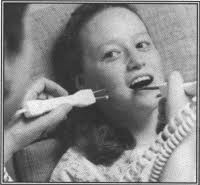Before you all get too excited and rush off to use microcurrent electrotherapy on yourself or your patients, there are a few things to be considered first.
As mentioned in the previous post, the current administered in microcurrent therapy is measured in microamperes and mimics the intensities produced by tissues (Maenpaa et al, 2004). For your comparison, the currents used in Transcutaneous Electrical Nerve Stimulation (TENS) are measured in milliamperes and can result in sensation and motor contraction, depending on parameters chosen for the intention of application (Curtis et al, 2010). This means that microcurrents are below the threshold required to stimulate sensory fibres, and the patient will have no perception of the electrical current (Curtis, 2010). For this reason, given that microcurrent is applied within its defining parameters, safety and comfort is mostly dependent on electrode placement and patient positioning.
As with all forms of electrical stimulation, a number of contraindications exist for the application of microcurrent therapy. However, the low intensity current means there aren’t many documented contraindications specific to microcurrent. The general contraindications for electrical stimulation are as follows (Zuim et al, 2005):
· Conditions of unknown aetiology
· Cardiac pacemakers
· Malignant tissues
· Placement over the carotid sinus or across the cerebrum
The safety regarding the following conditions have not been established and, as such, require extreme caution (Zuim et al, 2005):
· Pregnancy
· Epilepsy
· Pain of central origin
· Skin and vascular disorders
Mercola and Kirsch (1995) for the Journal of Advancement in Medicine stated that there are no known significant side effects to microcurrent electrical therapy, given these contraindications are considered.
So, as long as you remember your general contraindications and precautions regarding all electrical stimulation, microcurrent presents little risk to the general population. Comfort-wise, your patient shouldn’t feel the current, allowing them to lie back, relax and enjoy the ease of this particular treatment.
REFERENCES
Curtis, D., Fallows, S., Morris, M., & McMakin, C. (2010). The efficacy of frequency specific microcurrent therapy on delayed onset muscle soreness. Journal of Bodywork and Movement Therapies, 13(3), 272-279.
Curtis, D., Fallows, S., Morris, M., & McMakin, C. (2010). The efficacy of frequency specific microcurrent therapy on delayed onset muscle soreness. Journal of Bodywork and Movement Therapies, 13(3), 272-279.
Mercola, J.M., & Kirsch, D.L. (1995). The basis for microcurrent electrical therapy in conventional medical practice. Journal for Advancement of Medicine, 8(2), 107-120.
Maenpaa, H., Jaakkola, R., Sandstrom, M., & Von Wendt, L. (2004). Does microcurrent stimulation increase the range of movement of ankle dorsiflexion in children with cerebral palsy? Disability and Rehabilitation, 26(11), 669-677.
Zuim, P. R. J., Garcia, A. R., Turcio, K. H. L., & Hamata, M. M. (2006). Evaluation of microcurrent electrical nerve stimulation (MENS) effectiveness on muscle pain in temporomandibular disorders patients. Journal of Applied Oral Science, 14(1), 61-66.



